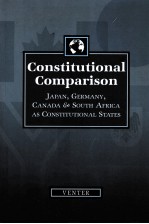

CONSTITUTIONAL COMPARISONPDF电子书下载
- 电子书积分:11 积分如何计算积分?
- 作 者:FRANCOIS VENTER
- 出 版 社:KLUWER LAW INERNATIONAL
- 出版年份:2000
- ISBN:9041115102
- 页数:274 页
Chapter 1 CONSIDERATIONS OF COMPARATIVE METHODOLOGY 1
1.1 Law and state as common denominators of humanity 1
1.1.1 The law 2
1.1.2 The state 4
1.1.2.1 The authority of the state 4
1.1.2.2 Emergence of the modern state 8
Feudalism 10
The Standestaat 10
Absolutism 11
The English parliamentary and cabinet system 11
The French Revolution 13
The Constitution of the United States 14
1.2 Comparative law: nature and issues 15
1.2.1 Is comparative law a method, a discipline or a science? 15
1.2.2 The need for a tertium comparationis 17
1.3 Comparison in the field of constitutional law 19
1.3.1 Constitutionalism 20
1.3.1.1 The hazards of definition 20
1.3.1.2 The faces of constitutionalism 20
Classic constitutionalism 21
Neo-classic constitutionalism 25
Conversions to constitutionalism 30
1.3.1.3 Crystallised constitutionalism 31
1.3.1.4 Contemporary challenges 34
1.3.2 The purposes of constitutional comparison 36
1.3.3 Published approaches to constitutional comparison 37
1.3.3.1 Empirical description 37
1.3.3.2 Historical exposition 39
1.3.3.3 Thematic comparison 39
1.3.3.4 Public law families 41
1.3.4 Layers of comparison 41
1.3.4.1 Comparison of the law of the constitution 42
1.3.4.2 Comparison of constitutional law 43
1.3.4.3 Constitutional history and constitutional comparison 43
1.3.4.4 Constitutional principles and doctrines and constitu- tional comparison 44
1.4 A matrix for constitutional comparison 44
1.4.1 Comparability 44
1.4.2 Distinction and classification 45
1.4.3 Attributes of the modern constitutional state 47
1.4.4 Stimulus, framework, purpose and focus 51
Chapter 2 PREDOMINANCE OF THE CONSTITUTION 53
2.1 Introduction 53
2.2 Why is the Constitution supreme? 53
2.3 History and foundations of the predominance of the constitution 59
2.3.1 Japan 60
2.3.2 Germany 63
2.3.3 Canada 66
2.3.4 South Africa 74
2.4 The impact of the predominance of the Constitution 79
2.4.1 Constitutional adjudication 79
2.4.1.1 The concept 79
2.4.1.2 The origins 80
2.4.1.3 The countermajoritarian dilemma 81
2.4.2 Operation of the judiciary under the Constitution 84
2.4.2.1 Japan 87
2.4.2.2 Germany 90
2.4.2.3 Canada 94
2.4.2.4 South Africa 98
2.4.3 Constitutional predominance in the legal system 104
2.4.3.1 Japan 106
2.4.3.2 Germany 110
2.4.3.3 Canada 114
2.4.3.4 South Africa 118
2.5 Comparative conclusions 123
2.5.1 The basic notion 123
2.5.2 The effect on legislation and the ligitimacy of the judiciary 124
2.5.3 Administrative acts and the Constitution 125
2.5.4 Government and the Constitution 125
2.5.5 Private relations and the Constitution 126
2.5.6 International law and the supreme constitution 126
Chapter 3 CONSTITUTIONAL RIGHTS 127
3.1 Introduction 127
3.2 The classification of constitutional rights 130
3.3 The culture of rights 132
3.3.1 Japan 133
3.3.2 Germany 135
3.3.3 Canada 137
3.3.4 South Africa 139
3.4 Analysis of selected constitutional rights 147
3.4.1 Property 147
3.4.1.1 Japan 147
3.4.1.2 Germany 149
3.4.1.3 Canada 151
3.4.1.4 South Africa 152
3.4.2 Access to the courts 156
3.4.2.1 Japan 156
3.4.2.2 Germany 158
3.4.2.3 Canada 159
3.4.2.4 South Africa 160
3.4.3 Academic freedom 163
3.4.3.1 Japan 163
3.4.3.2 Germany 164
3.4.3.3 Canada 166
3.4.3.4 South Africa 168
3.4.4 Citizenship 170
3.4.4.1 Japan 170
3.4.4.2 Germany 171
3.4.4.3 Canada 172
3.4.4.4 South Africa 173
3.4.5 State-sponsored education 175
3.4.5.1 Japan 175
3.4.5.2 Germany 176
3.4.5.3 Canada 178
3.4.5.4 South Africa 179
3.5 Limiting and balancing interests 181
3.5.1 Japan 181
3.5.2 Germany 183
3.5.3 Canada 185
3.5.4 South Africa 187
3.6 Conclusion: constitutional rights in the contemporary constitutional state 190
Chapter 4 DEMOCRACY AND THE DISTRIBUTION OF AUTHORITY 193
4.1 Introduction 193
4.2 Democracy 193
4.2.1 Working with the undefinable 193
4.2.2 Democratic representation and its British roots 195
4.2.3 Contemporary reach of democracy 200
4.2.3.1 Democracy as a universal right 201
4.2.3.2 The operation of democracy in the constitutional state 202
4.2.4 Democracy in the Constitutions 204
4.2.4.1 Japan 204
4.2.4.2 Germany 206
4.2.4.3 Canada 208
4.2.4.4 South Africa 209
4.3 The horizontal distribution of authority 211
4.3.1 Separation of Powers in the Constitutions 214
4.3.1.1 Japan 214
4.3.1.2 Germany 216
4.3.1.3 Canada 219
4.3.1.4 South Africa 220
4.3.2 Some comparative deductions 223
4.4 The vertical distribution of authority 224
4.4.1 Vertical distribution in the Constitutions 229
4.4.1.1 Japan 229
4.4.1.2 Germany 230
4.4.1.3 Canada 235
4.4.1.4 South Africa 241
4.4.2 Some comparative deductions 254
4.5 Democracy and Authority in the Constitutional State 255
Chapter 5 COMPARING CONSTITUTIONS IN 2000 256
5.1 Motives for practising comparative constitutional law 256
5.2 Limitations of constitutional comparison 257
5.2.1 The state of statehood 257
5.2.2 Comparability 262
5.3 A method for comparing constitutions 263
INDEX 265
- 《对冲基金手册》(美)弗朗索瓦·塞尔·拉比唐(Francois-SergeLhabitant)著 2014
- 《建筑艺术与室内设计 1997.1 总14》(意)弗朗索瓦·布克哈特(Francois Burkhardt)主编;王晖等译 1997
- 《什么是电影叙事学》(加)安德烈·戈德罗(Andre Gaudreault),(法)弗朗索瓦·若斯特(Francois Jost)著;刘云舟译 2005
- 《阿涅丝的最后一个下午 米兰·昆德拉作品论》(加)弗朗索瓦·里卡尔(Francois Ricard)著;袁筱一译 2005
- 《两种声音的回忆》(法)弗朗索瓦·密特朗(Francois Mitterrand),(法)埃利·维厄瑟尔(Elie Wiesel)著;胡洪庆译 2000
- 《功效论 在中国与西方思维之间》宇莲(Francois Jullien)著 2015
- 《文化产业营销与管理》(加)弗朗索瓦·科尔伯特(Francois Colbert)著;高福进等译 2002
- 《情绪的力量 爱情、愤怒、快乐……》(法)佛朗索瓦·勒洛尔(Francois Lelord),(法)克立斯托夫·安得烈(Christophe Andre)著;杨燕明译 2004
- 《闲话读书》(法)安妮·弗朗索瓦(Annie Francois)著;俞佳乐,唐媛圆译 2001
- 《后现代性与公正游戏 利奥塔访谈、书信录》(法)利奥塔(Jean-Francois Lyotard)著;谈瀛洲译 1997
- 《Foundations of criminal law》[edited] by Leo Katz 1999
- 《SCHLESINGERS COMPARATIVE LAW》UGO A.MATTEI TEEMU RUSKOLA ANTONIO GIDI 2009
- 《信念共同体:法与经济学的新方法=THE REPUBLIC A NEW APPROACH TO LAW AHD ECONOMICS》(印)考希克·巴苏(KaushilBasu)著 2020
- 《人工智能法学简论=A BRIEF DISCUSSION ON THE LAW OF ARTIFICIAL INTELLIGENCE》孙建伟 2019
- 《国际商法 第8版=INTERNATIONAL COMMERCIAL LAW》张圣翠主编 2020
- 《Law:its origin growth and function》by James Coolidge Carter 1907
- 《公司法学》(英)泰勒著 2014
- 《施米托夫论出口贸易 国际贸易法律与实务 上 第11版》克利夫·M·施米托夫,卡罗尔·默里,戴维·霍洛韦等著;冷柏军主译 2014
- 《雇员与公司治理》(美)布莱尔,(美)罗伊编著 2014
- 《施米托夫论出口贸易 国际贸易法律与实务 上 第11版》克利夫·M·施米托夫,卡罗尔·默里,戴维·霍洛韦等著;冷柏军主译 2014
